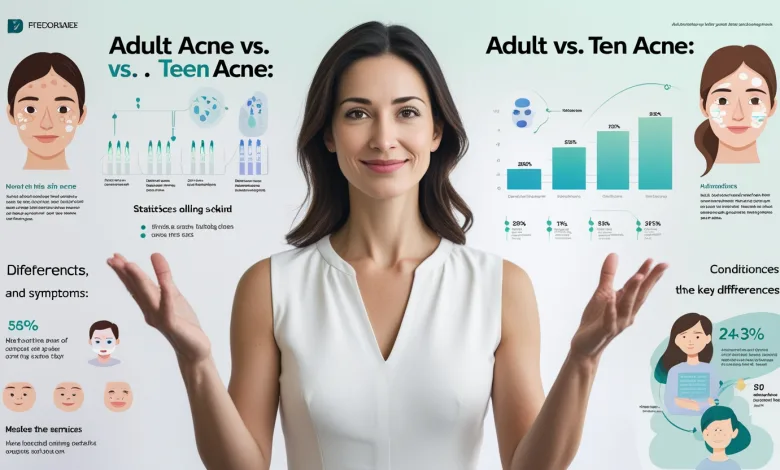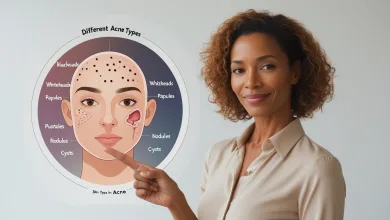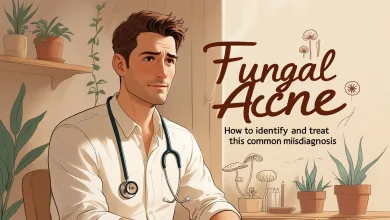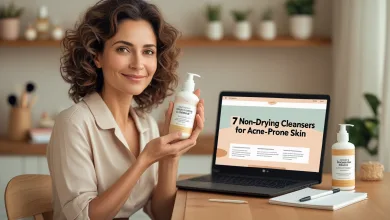Adult Acne vs. Teen Acne: Understanding the Key Differences

Dealing with acne isn’t just a teenage rite of passage—it affects millions of adults too, but for surprisingly different reasons. Let’s dive into why these two types of acne require completely different approaches and how understanding these distinctions can finally help you achieve clearer skin, regardless of your age.
The Surprising Comeback of Acne in Adulthood
You thought you’d left those pesky pimples behind with your high school yearbook, didn’t you? Well, you’re not alone. Many adults are shocked when acne makes an unwelcome comeback in their 20s, 30s, or even 40s. In fact, studies show that adult acne affects approximately 15% of women and 5% of men over age 25, with some experiencing it well into their 50s.
But here’s the thing—adult acne isn’t simply a replay of your teenage breakouts. It’s an entirely different beast, with its own unique causes, patterns, and treatment needs. Understanding these differences isn’t just interesting—it’s absolutely crucial for effectively treating your skin concerns. The strategies that worked when you were 16 probably won’t cut it now, and that’s exactly why so many adults get frustrated when trying to manage their persistent breakouts.
Location, Location, Location: Different Acne Patterns
Where Teen Acne Typically Appears
Remember those dreaded T-zone breakouts? Teen acne typically shows up front and center—literally. The forehead, nose, and chin (collectively known as the T-zone) bear the brunt of teenage acne attacks. This distribution isn’t random; it directly correlates to where teens produce the most sebum (skin oil).
During adolescence, sebaceous glands go into overdrive, particularly in the center of the face. These overactive oil factories can produce up to five times more sebum than adult skin, creating the perfect environment for acne-causing bacteria to thrive. This is why teenage acne often presents as those classic whiteheads, blackheads, and the occasional angry red pimple scattered across the central face region.
Adult Acne’s Distinctive Pattern
In stark contrast, adult acne plays by different rules. It tends to be more strategic in its attack, focusing primarily on the lower third of the face—think jawline, chin, and around the mouth. Dermatologists often refer to this as the “U-zone” instead of the T-zone. And it’s not just location that’s different; adult acne typically presents as deeper, more painful nodules rather than surface-level pimples.
What’s particularly frustrating for adult acne sufferers is the cyclical nature of these breakouts. Many women report predictable flare-ups tied directly to their menstrual cycles, with new lesions appearing in the same spots month after month. This pattern strongly suggests hormonal influences rather than just excess oil production, which we’ll explore further in the next section.
Hormonal Triggers: Different Life Stages, Different Culprits
The Teenage Hormone Tsunami
Let’s face it—puberty is basically one giant hormonal roller coaster. During adolescence, the body experiences a significant surge in androgens (male hormones present in both boys and girls). This hormone spike triggers sebaceous glands to produce excessive oil, creating the perfect breeding ground for P. acnes bacteria. It’s essentially a perfect storm for pimple production.
The teenage endocrine system is still figuring things out, which explains why acne can be so widespread and unpredictable during these years. Fluctuations happen rapidly, and the skin simply can’t adjust quickly enough. That’s why teen acne often appears more inflammatory and can cover larger areas of the face, chest, and back. There’s nothing subtle about these hormonal changes—they’re dramatic, and unfortunately, so is the resulting acne.
Adult Hormonal Factors: Subtle but Persistent
Adult acne, however, operates with more finesse. Rather than the dramatic spikes of puberty, adults experience more subtle hormonal imbalances that can be triggered by numerous factors. For women, the monthly cycle creates mini hormone fluctuations that can drive breakouts, particularly during the premenstrual phase when progesterone rises.
Other significant hormonal disruptors in adulthood include:
- Pregnancy and postpartum hormone shifts
- Perimenopause and menopause transitions
- Polycystic ovary syndrome (PCOS)
- Stress-induced cortisol increases
- Hormonal contraceptive changes or discontinuation
What’s particularly sneaky about adult hormonal acne is that it can appear even when hormone levels technically fall within “normal” ranges. It’s often about sensitivity to hormones rather than absolute levels. That’s why some people with seemingly normal endocrine panels still struggle with persistent acne (Journal of Clinical Endocrinology, 2024).
Lifestyle Factors: Different Ages, Different Challenges
Teen Lifestyle Contributors
Teenagers live in a unique world of rapid physical development, irregular schedules, and let’s be honest—sometimes questionable hygiene habits. Diet plays a significant role, with studies increasingly suggesting links between high-glycemic foods (think sugary snacks and sodas) and acne severity. The typical teen diet, often heavy on processed foods and dairy, may exacerbate breakouts.
Sports and physical activities can also impact teen acne. Equipment like helmets and shoulder pads create friction and trap sweat against the skin, leading to what dermatologists call “acne mechanica.” And we can’t overlook the simple fact that many teens haven’t yet established consistent skincare routines, sometimes over-washing when they do remember or using harsh products that strip the skin.
Adult Lifestyle Triggers
Adults face an entirely different set of lifestyle challenges. Chronic stress has become practically endemic in adult life, triggering cortisol production that can throw hormones out of balance and increase inflammation. Poor sleep quality—another adult epidemic—impairs skin repair mechanisms and alters hormone regulation.
Career demands often lead to makeup worn for extended periods, phone-to-face contact that transfers bacteria, and less-than-ideal eating patterns. Many adults also experience the effects of cumulative sun damage, which alters how the skin functions and heals.
Perhaps most interestingly, modern adult skincare routines can sometimes contribute to breakouts. The trend toward multi-step routines and active ingredients can lead to over-exfoliation and damaged skin barriers. That expensive 10-step routine might actually be making things worse!.
Treatment Approaches: Why One Size Doesn’t Fit All
Effective Teen Acne Treatments
Teen acne treatments typically focus on controlling excess oil production and fighting bacteria. The classic approach often involves:
- Benzoyl peroxide to kill bacteria and reduce inflammation
- Salicylic acid to exfoliate and clear pores
- Retinoids to normalize skin cell turnover
- Topical antibiotics for more severe cases
These treatments work effectively because they address the primary drivers of teen acne—oil and bacteria. Most teenagers can tolerate stronger formulations since their skin typically has robust barrier function and heals quickly. In severe cases, oral antibiotics or isotretinoin (Accutane) may be recommended under dermatologist supervision.
Adult-Specific Treatment Strategies
Adult acne demands a more nuanced approach, often targeting hormonal factors and addressing skin that’s simultaneously dealing with aging concerns:
- Spironolactone and other anti-androgenic medications
- Birth control pills specifically formulated for acne management
- Lower-percentage retinoids that address both acne and fine lines
- Gentle chemical exfoliants like lactic and mandelic acids
- Anti-inflammatory ingredients including niacinamide and azelaic acid
Adult skin typically benefits from gentler, more hydrating formulations that won’t exacerbate sensitivity or dryness. Treatment plans often need to balance acne control with anti-aging concerns—a juggling act that teen products simply aren’t designed for.
Psychological Impact: Different Life Stages, Different Emotional Effects
The Teen Experience
For teenagers, acne hits during a critical period of identity formation and social development. Studies consistently show that teen acne can significantly impact self-esteem and body image during these formative years. The visibility of facial acne comes exactly when teens are most sensitive to peer perception.
Social media has only intensified this pressure, with filtered images creating unrealistic skin standards. Many teens report avoiding social activities or experiencing anxiety and depression related to their skin condition. The good news is that there’s often a cultural understanding that acne is part of adolescence, providing some normalization.
The Adult Psychological Burden
Adults with acne face a different psychological challenge—they’re dealing with a condition many believe should have been “outgrown.” There’s often less social acceptance for adult acne, with sufferers reporting feelings of embarrassment and perception of being judged for poor hygiene or health.
Professional contexts add another layer of stress, as many adults feel acne affects how they’re perceived in the workplace. Dating and intimate relationships can also be complicated by persistent acne. Perhaps most frustratingly, adult acne often coincides with the first signs of aging, creating the double whammy of treating wrinkles and breakouts simultaneously—a psychological burden that teens simply don’t face.
Prevention Strategies: Age-Appropriate Approaches
Teen Prevention Fundamentals
Preventive measures for teens should focus on consistency and simplicity. Effective strategies include:
- Establishing a basic but consistent cleansing routine (morning and night)
- Using non-comedogenic moisturizers and sunscreens
- Choosing oil-free makeup and skincare products
- Regular cleaning of items that touch the face (phone screens, pillowcases, sports equipment)
- Managing stress through physical activity and adequate sleep
- Considering dietary modifications, particularly reducing dairy and high-glycemic foods
For teens, the emphasis should be on building sustainable habits rather than pursuing complex skincare regimens that may be difficult to maintain.
Adult Prevention Strategies
Adults benefit from a more comprehensive approach to prevention that addresses hormonal fluctuations and aging concerns:
- Stress management techniques including meditation and yoga
- Sleep hygiene practices that optimize hormone regulation
- Anti-inflammatory diet rich in omega-3 fatty acids and antioxidants
- Careful product selection to avoid over-exfoliation and barrier damage
- Regular professional treatments like light therapy or specialized facials
- Hormone-balancing practices such as seed cycling or adaptogens (with medical supervision)
- Consistent use of retinoids for both acne prevention and anti-aging benefits
The key difference for adults is addressing the underlying hormonal and inflammatory factors while supporting overall skin health and barrier function.
FAQs About Adult vs. Teen Acne
Q: Can adult acne be caused by the same bacteria as teen acne? A: Yes, Propionibacterium acnes (P. acnes) bacteria plays a role in both adult and teen acne. However, studies suggest that adults may have different strains of the bacteria, and inflammation rather than bacterial overgrowth is often the primary driver in adult cases.
Q: Is adult acne more difficult to treat than teen acne? A: Generally, yes. Adult acne tends to be more persistent and less responsive to traditional treatments because it often has complex hormonal underpinnings. Additionally, adult skin typically heals more slowly and is more prone to post-inflammatory hyperpigmentation, making the overall treatment journey longer.
Q: Can pregnancy trigger adult acne even if I’ve never had it before? A: Absolutely. The dramatic hormonal changes during pregnancy can trigger acne in women who have never experienced it previously. About 42% of pregnant women experience some form of acne, typically during the first and second trimesters when androgen levels are highest.
Q: Should teenagers and adults use different skincare products for acne? A: Yes! Teen skin typically benefits from oil-control products that can be too drying for adults. Adult skin often requires gentler formulations with added hydration and anti-inflammatory ingredients. Using teen-focused products in adulthood can actually worsen acne by irritating and dehydrating the skin.
Final Thoughts: Moving Beyond One-Size-Fits-All Acne Care
Understanding the fundamental differences between adult and teen acne isn’t just academically interesting—it’s the key to finally achieving clear skin. When you recognize that these two conditions stem from different causes and require different approaches, you can stop the frustrating cycle of using treatments that simply weren’t designed for your specific situation.
For teenagers, there’s reassurance in knowing that with appropriate treatment and patience, most acne will improve with time as hormones stabilize. For adults, recognizing the complex interplay of hormones, lifestyle, and aging skin means you can take a more holistic approach to treatment rather than just focusing on typical acne products.
The most important takeaway? Don’t go it alone. Both teens and adults benefit enormously from professional guidance. A dermatologist can help identify the specific type and causes of your acne and create a personalized treatment plan that addresses your unique situation, saving you time, money, and frustration in the long run.
Whether you’re 16 or 46, clear skin is possible—it just might require a different path to get there.






